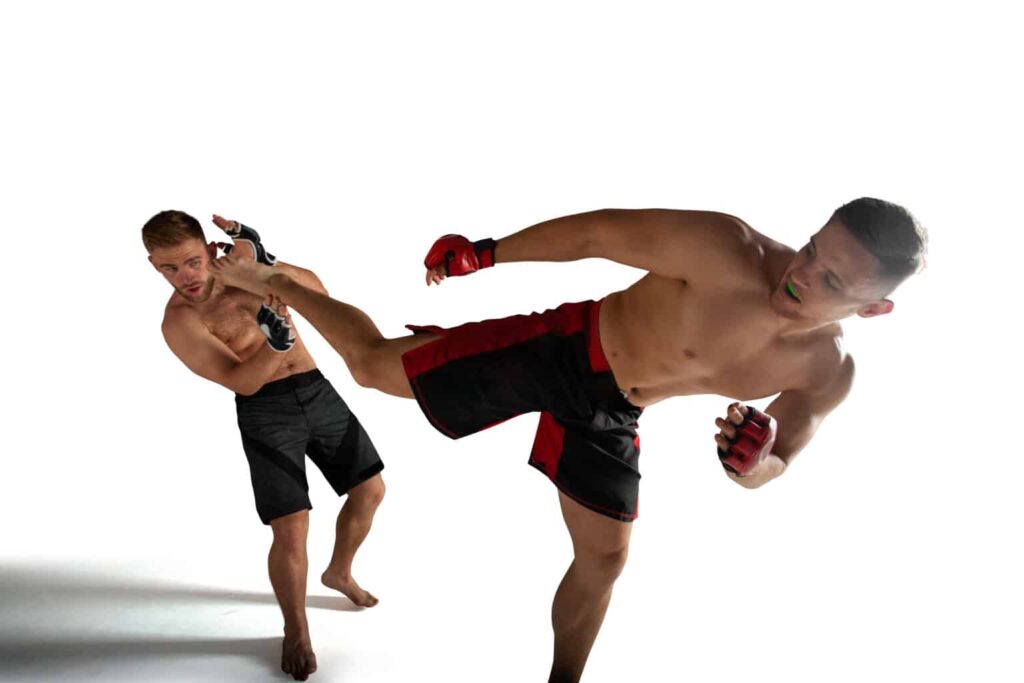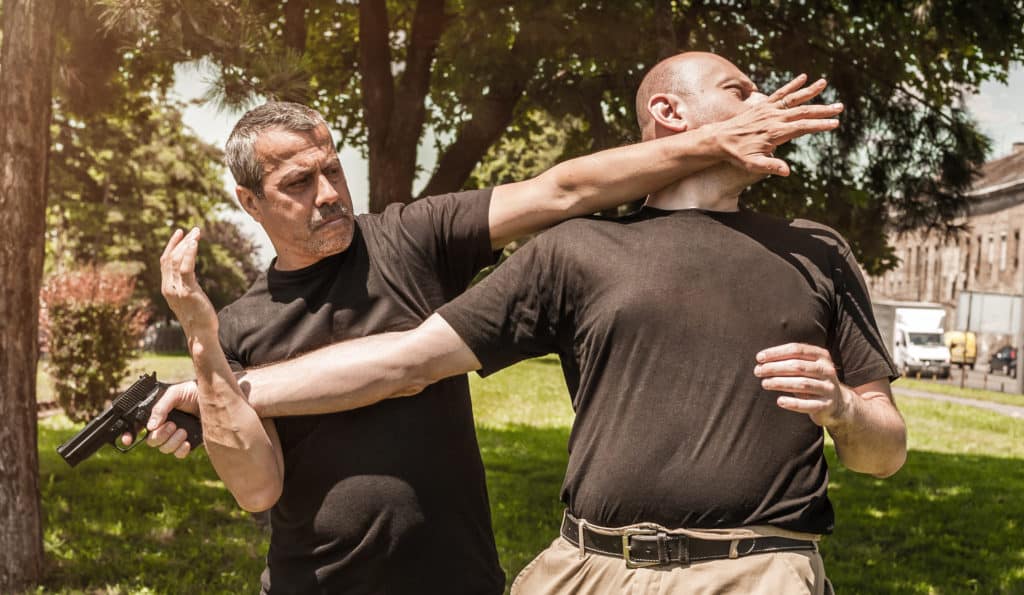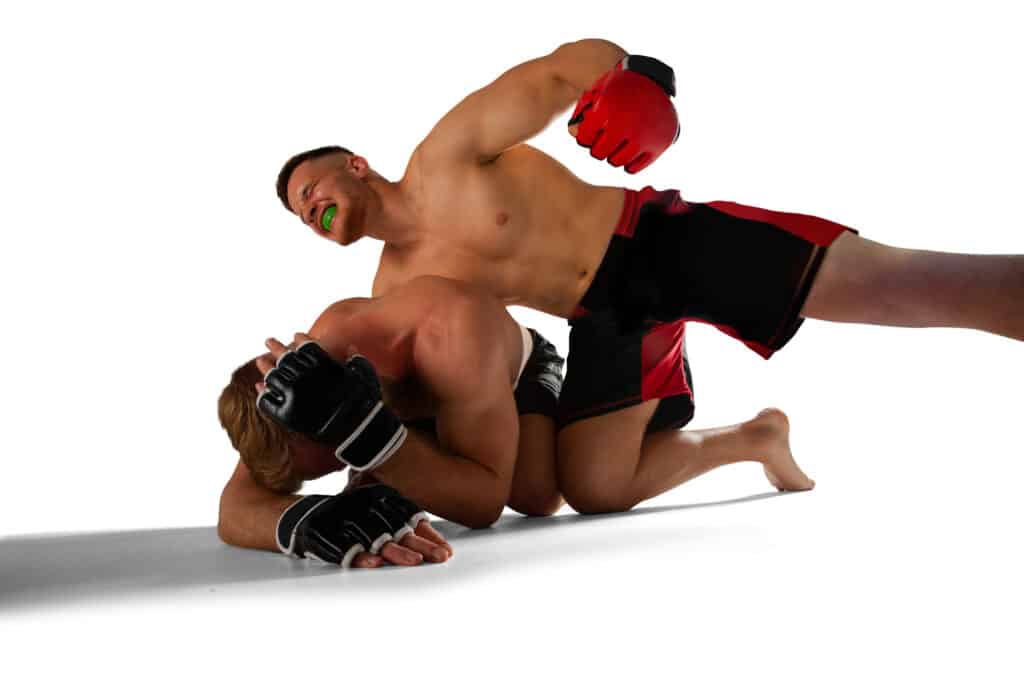In this post we look at 9 different hybrid martial arts styles from all over the world.
Mixed martial arts or MMA is commonly associated with the hugely popular cage competition fights of the UFC.
But there are other types of mixed/hybrid martial arts styles that have been trained and practiced long before the UFC came about.
The styles listed and discussed in this post can all be defined as hybrid martial arts styles or a mixed martial style.
We take a look at the most popular types of hybrid martial arts styles in the world today and discuss what the characteristics of these styles are that defines them as hybrid martial arts or a mixed style of martial arts.
Some of these styles have been around for centuries and others came about in modern martial arts history. Some are purely sport styles and others focus more on combat and self defense.

In order to qualify as a hybrid martial art style, the styles included in this post incorporate the following:
- Stand up striking
- Grappling (stand up or ground grappling)
- Submissions
Some of them are based on traditional martial arts and specifically incorporate these styles or they were developed as a distinct style that includes striking and grappling (either stand up or ground based grappling).
1.Jeet Kune Do
Jeet Kune Do is a hybrid martial arts style that was created by Bruce Lee in 1967. Jeet Kune Do is based on Bruce Lee personal philosophies and ideas around combat and martial arts.
Jeet Kune Do is a Cantonese name that translates to, “Way of the Intercepting Fist”.
Main Features of Jeet Kune Do
Controlling the Centerline
Controlling and protecting the centreline is a major concept of Jeet Kune Do.
This forces the opponent to attack from the ‘outside’. This concept is drawn from Bruce Lee’s early training in Wing Chun under Ip Man.

Focus on Low Kicks
Jeet Kune Do focuses on low kicks to the opponents shins, knees, legs and torso.
The low kick can be delivered with more efficiency and with economy of motion.
The distance travelled to the opponents lower body is much shorter than high kicks and thus can be delivered faster as well.
Simultaneous Defense and Offense
Jeet Kune Do’s defensive philisopohy promotes attack and defense at the same time and in one action.
In JKD it is taught that it is better to parry an attack and hit at the same time or even better intercept the attack and strike,
Jeet Kune Do – Martial Arts Influences
- Wing Chun
- Boxing
- Fencing
- Silat
- Eskrima
2.Kudo
Kudo is a Japanese hybrid martial arts style and a full-contact combat sport.
Kudo when translated into English means, “Way of the Open Mind”.
Kudo includes punches, kicks, takedowns, throws, locks and submission techniques on the ground.
Kudo was created by Takashi Azuma who was a 9th degree black belt in Kyokushin and 3rd degree black belt in Judo.
Characteristis of Kudo
Use of Protective Gear
One of the overarching goals of Kudo is be as close as possible to realistics combat while also ensuring as much as possible safety of the fighters in competition.
All Kudo fighters must wear a protective helmet that includes a plexiglass visor and is unique to Kudo.
The gloves used are similar to MMA gloves and do not cover the fingers to allow for more effective grappling than standard boxing gloves.
Spiritual and Mental Focus
Kudo also has a focus on three important concepts that work to develop the spiritual and mental aspects of the Kudo student.
Mujou kan – represents a view of life or a perspective of the world. In this approach, you can crush and change the form of everything in life that has a shape. As a result, we shouldn’t attach ourselves to objects and things in life.
Sougo izon – in this concept, everything that exists in life, exists because it depends on each other. In other words, a human being shouldn’t be self-righteous or self-conceited.
Huhen Huto – this concept has an open-minded view of the world and the way of living in general. This means you should always face difficulties in life with a positive attitude. Further, we shall never run from life issues but challenge and overcome them.
Kudo Martial Arts Influences
- Kyokushin
- Judo
- Boxing
- Muay Thai
- Jiujitsu
- Wrestling
3.Pankration
Of the types of hybrid martial arts styles in the World today, Pankration is the oldest.
Pankration is a martial art that was developed and practiced by ancient Greeks.
It was the first style of mixed martial arts in recorded history, with origins in Greek mythology as well as all-style wrestling.
Pankration is a combination of boxing and wrestling techniques, but also includes joint locks, chokes, kicks, takedowns and other combat moves.
Translated to English Pankration means ‘all force’.
Characteristis of Pankration
Military Combat Based
Pankration was part of the army training of many Greek city-states. It was the core of the military instruction of the hoplites (the famous Greek infantry). The Spartans were particularly well-trained and excelled in that art
All Out Unarmed Combat
In Pankration contests, everything was permitted except biting, gouging (stabbing with your finger in your opponent’s eye, nose or mouth) and attacking the genitals.
Pankration Martial Arts Influences
- Greek Wrestling
- Greek Boxing
4.Kajukenbo
Kajukenbo is a hybrid martial arts style that was founded in Hawaii by 5 martial artists of different backgrounds.
Kajukenbo is often referred to as ‘the original mixed martial art’.
The founders of Kajukenbo were:
- Adriano Directo Emperado — Kara-Ho Kenpo, Arnis and Ng Ying Kung Fu.
- Joseph Holck — Judo and Danzan-ryu Jujutsu.
- Peter Young Yil Choo — Tang Soo Do, Shotokan Karate and Boxing.
- Frank F. Ordonez — Danzan-ryu Jujutsu.
- Clarence Chang — Boxing, Chin Na and Ng Ying Kung Fu
Kajukenbo or commonly referred to as Kaju came about as a system developed for Hawaiian locals to be able to defend themselves against Navy sailors.
The word “kajukenbo” comes from the Okinawan words “kai” (to strike), “ju” (to break) and “kenpo” or karate (empty hand).
Kajukenbo was developed in Hawaii but has grown to be popular throughout the world.
This martial arts style emphasizes on striking techniques such as punches and kicks which are executed from a long range or close quarters.
Grappling skills including joint locks and chokes are used for defense against an opponent’s strikes or to finish a match quickly by submission.
Throws can be utilized when executing ground fighting techniques like pins, sweeps, submissions (chokeholds), etc.; while weapons defenses includes defending against blades (knives) with blocking maneuvers followed by disarming the weapon hand
Characteristics of Kajukenbo
Self Defense Focus
Kajukenbo is known a hybrid martial arts fighting style for those who are seeking self-defense skills and not full on combat or tournament fighting styles.
The goal of Kajukenpo is to teach people how to use their surroundings as weapons and defend themselves from harm using everyday items such as pens, keys, shoes, jackets and even clothing like belts or pantyhose.
Spiritual Development
The spirituality involved with Kajukenbo teaches lessons like how to focus your energy to obtain positive outcomes for the practitioner while overcoming negative aspects in order to find personal balance between the physical, mental and spiritual.
Kajukenbo Martial Arts Influences
- Okinawan Karate
- Shotokan Karate
- BJJ
- Muay Thai
- Wrestling
5.Krav Maga
Krav Maga is a self-defense system that was created in Israel.
The word Krav Maga is Hebrew for “contact combat.”
It is a military self-defense system that utilizes natural body movements and instinctive reactions to avoid or neutralize an attack.
The principles of this martial art are universal, meaning they can be applied to any person regardless of age, gender, size or fitness level.
Characteristics of Krav Maga
Suited for All
Krav Maga is designed to be used by an individual with no combat training and little or no weapons as well as someone who has a lot of training and experience.
Self Defense Focus
There is no competitive sport version of Krav Maga and the focus is completely on real world combat and self defense.

Krav Maga can be summarized by “don’t get hit.”
This means you want to avoid the attacker coming near you, deliver your own strikes whenever possible, and don’t take any chances when it comes to defending yourself from being attacked.
6.Combat Sambo
Sambo is a Russian type of hybrid martial arts style that was developed in the 1920s to be used and trained by the Russian Army.
Sambo was created to be a hybrid martial art that incorporated the most effective techniques of other martial arts.
Sambo is an acronym that translates to mean, “self defense without weapons”.
Combat sambo allows regular punches, kicks, elbows, and knees, as well as throws, holds, chokes and locks.

Characteristics of Combat Sambo
Developed for Military Combat
Sambo was developed to be trained and used by the Russian military and thus the focus was on battlefield combat techniques.
Use of the Traditional Judo Gi
A distinct feature of Sambo is the use of a Red or Blue Judo Gi to allow for gripping for throwing and grappling.
But the traditional Judo long trousers are replaced by above knee length pants in all compeitions.
Martial Arts Influences
- Wrestling
- Judo
- Boxing
- Kickboxing
7.Sanda/San Shou
Sanda is often used interchangeably with the term Sanshou which translates as ‘free hand fighting’ while Sanda translates as ‘free style fighting’.
Sanda or San Shou is a hybrid martial art or “mixed” style that includes traditional Chinese kung fu and more modern styles.
In China where the sport originates, Sanda is the term more commonly used while Sanshou is more familiar in North America.
Sanda was created by the Chinese military in the time of the Chinese Nationalist Party’s (around the 1920’s) rule in Mainland China prior to the Communist takeover.
The Chinese Nationalist Party or Guomindang aka Kuomintang used Sada for the training of its military for unarmed combat.
Characteristics of Sanda/San Shou
Stand Up Grappling Only
Unlike other types of mixed martial arts styles dicussed in this post, Sanda is the only style that does not allow ground fighting in competition.
While there is no ground fighting in Sanda, includes pretty much all of the striking and stand up grappling techniques allowed in most mixed martial arts competitions and styles are included in Sanda.
Similar to kickboxing and muay thai the fight stops when an opponents is downed and resumes with both fighters back on their feet.
Fights Take Place on an Open Platform
Sanda fights do not take place in a ring or cage but on an elevated platform called a ‘letai’.
The ‘letai’ is 80cm in height and 8m x 8m in length and width.
8.Vale Tudo
Vale Tudo means ‘anything goes’.
It is a Brazilian hybrid combat martial art. Vale Tudo is a type of mixed martial arts style that started out with basically no rules but has evolved over time into a combat sport with rules similar to modern day MMA.
Vale Tudo fights started around 90 years ago in Brazil.
The original Vale Tudo fights were first organized by Brazilian circus promoters as a sideshow attraction.
The fights featured fighters with different backgrounds and disciplines similar to the early Gracie fights, to show whos style was superior in a one on one fight.
Characteristics of Vale Tudo
No Holds Barred combat
Early Vale Tudo matches in the 1920s and 30s were closer to a street fight than a combat sport.
There was very little by way or rules governing a Vale Tudo fight.
Over the years however, rules were introduced that grew Vale Tudo as more of a combat sport and it came to resemble more of a modern MMA contest.
Therefore head butts and groin strikes were banned with the onset of modern combat sport competition.
Carnival/Circus Events in Origin
Simlar to early catch as catch can wrestling in the West which orginated in travelling circus shows, Vale Tudo also came from Carnivals and Circus events.
However while catch wrestling offered opportunities for spectators to compete against travelling wrestlers, Vale Tudo featured scheduled fighter’s for spectators to watch.
9.Shootfighting
Shootfighting is a type of mixed martial art style and combat sport that began in the 1970s. Shootfighting is a hybrid style that incorporates striking and grappling similar to modern day MMA.
Shootifghitng has its origins in Jaapanese professional wretlers and specifically from the 1970’s when legendary Catch Wrestler, KArl Gotch taught a group of Japanese wretlers catch wrestling techniques.
These catch wrestling techniques were called “shooting” or “hooking”.
One of the Japanese pro wrestlers Gotch taught, Antonio Inoki hosted “mixed” martial arts contests in 1976. These events caught on in popularity and led to the establishment of mixed martial arts contests called “shoots”.
Shootfighting came from Japan but the term itself ‘shootfighting’ was coined by American professional wrestler Bart Vale.
Vale used the term shootfighting to describe his hybrid style which included the shoot wrestling he learned in Japan and his own martial arts experience from Kenpo, Jiujitsu and Muay Thai.
Vale also founded the International Shootfighting Association to promote shootfighting as a combat sport.
Characteristics of Shootfighting
Variety of Rule Sets Depending on Organization
Generally across shootfighting organizations the rules are very similar to MMA. However some organizations do allow headbutting. Also organizations that do not use gloves disallow punches to the head although open palm slaps to the face and head are allowed.
Grappling and Submissions are a Major Focus
As shootfighitng originated out of JApanese wrestling with influence from catch wrestling – it is generally more common to see fights won by submission which can include leglocks among other submission techniques.
Shootfighters are generally very good wrestlers with strong takedowns and taekdown defense as well as ground control.
Shootfighting – Martial Arts Influences
- Catch Wrestling
- Kenpo
- Jiujitsu
- Kickboxing
- Judo




